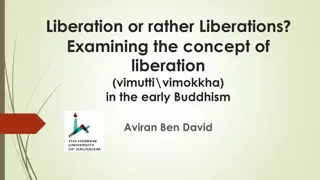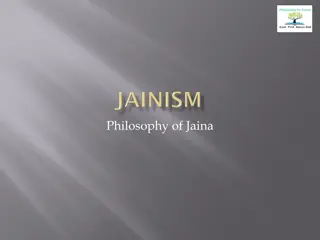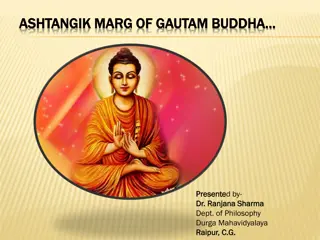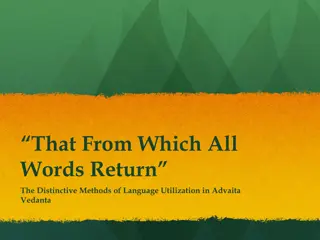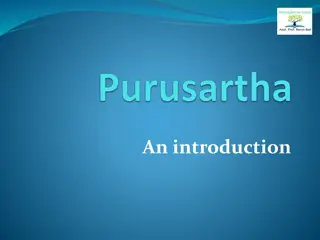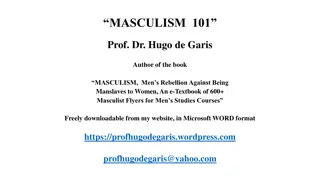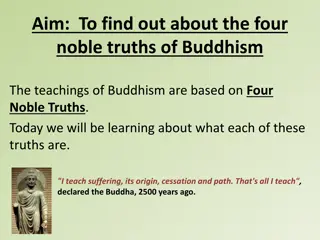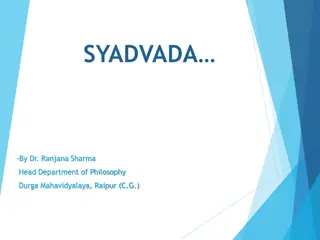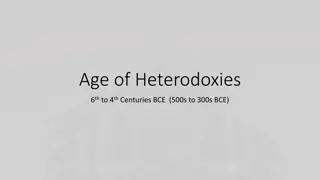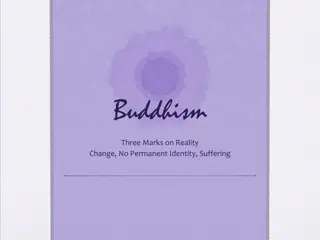Understanding Jainism: Path to Liberation and Right Conducts
Jainism, an ancient religion, emphasizes the path to liberation through Triratna - right faith, knowledge, and conduct. The teachings of Tirthankars guide followers towards dissociation of the soul from matter and practicing virtues like forgiveness, truthfulness, and celibacy to eliminate karmas. By meditating on self-truth and practicing restraint, believers aim to conquer discomforts and attain spiritual enlightenment.
Download Presentation

Please find below an Image/Link to download the presentation.
The content on the website is provided AS IS for your information and personal use only. It may not be sold, licensed, or shared on other websites without obtaining consent from the author. Download presentation by click this link. If you encounter any issues during the download, it is possible that the publisher has removed the file from their server.
E N D
Presentation Transcript
Presented By Dr. Ranjana Sharma Head Dept. of Philosophy, Durga Mahavidyalaya Raipur, C.G. Presented By- - Dr. Ranjana Sharma Head Dept. of Philosophy, Durga Mahavidyalaya Raipur, C.G.
There are 24 Tirthankars in Jainism. The name of the first Tirthankar was Rishabhdev. Vardhaman Mahavira was the last Tirthankar. He is said to have lived in the 6th century B. C. Parshvanath, the 23rd Tirthankar lived in the 9th century B.C. The other 22 Tirthankars belong to the prehistoric period.
Triratna is the Path to Liberation. Liberation is the complete dissociation of the soul from matter. This stops the influx of new matter into the soul. This completely eliminates the matter which had been already attached to the soul. Samyag Darshan, Samyag Gyan, Samyag Charitra are the Triratnas of Jainism.
Samyag Darshan means right faith. We must have faith in the competence of these Teachers i.e. Tirthankars. We must have faith in their teachings. Jain Darshnik Umaswami defines Right Faith as the attitude of respect [shraddha] towards Truth. Faith may be inborn or it may be acquired by learning or culture.
SamyagGyan means RightKnowledge. The right knowledge is about the real nature of Jiva and Ajiva. This right knowledge is free from doubt, error and uncertainty. A Jiva or a soul is a conscious substance. The soul is eternal and different from the body.
SamyagCharitra means RightConducts. Good conduct helps the self to get rid of the karmas that lead to bondage and sufferings. This good conduct stops the influx of new karmas and eradicates the old one. It means one should follow the Five Great Vows[Panch Mahavrat]. Some believers of Jainism believe in Practising extreme carefulness in walking ,speaking , receiving alms and answering calls of nature.
Practice restraint of thoughts, speech and bodily movements. Practice Ten Dharmas Forgiveness,Humility,Straightforwardness,Truthfulness,Cl eanliness,Self-restraint,Austerity[internal and external],Sacrifice, Non-attachment and Celibacy. Meditate on the truth taught regarding the self and the world. Conquer through fortitude all pains and discomforts that arise from hunger , thirst, heat, cold,etc.
Attain Equanimity, Purity, Absence of Greed and Perfect conduct. Some Jain Darshanik believe that only Five Great Vows Panch Mahavrat is sufficient for Samyag Charitra i.e. Right Conduct.
Ahinsa Satya Asteya Brahmacharya Aparigrah
Abstinence from all Injuries to life. Jain Darshniks believe in moving beings[trasa] as well as in non moving beings[sthavara]. Non moving ones [sthavara]live in Plants and other Panchtatva. Ahimsa should not only be for Moving creatures but also for Non moving ones. Neither one should think , speak nor do Hinsa nor permit or encourage others for violence.
Abstinence from Falsehood . Truthfulness is not speaking what is only true but speaking what is true as well as good and pleasant. For the perfect maintenance of this vow one must conquer greed, fear, anger and even restrain the habit of jesting. This vow also is taken very rigorously.
Abstinence from Stealing. This vow consists in not taking what is not given. Jain Darshniks recognise the property of others as their lives. Wealth is the outer life of man so to rob the wealth is to rob the life. This vow is logically inseparable from the vow of Ahimsa.
Abstinence from Self Indulgence. To give up kaam [self-indulgence] of every form. To conquer all senses. Desist from all external , internal , subtle and gross , mundane and extra mundane , direct and indirect forms of self indulgence. In speech ,in thought, in the hopes of enjoyment hereafter in heaven , even in asking or permitting others to indulge themselves is prohibited.
Abstinence from all Attachments. To give up all attachments for the objects of the five senses-pleasant sound , touch , color , taste and smell . One should abstain from hoarding. Attachment to the world s objects means bondage . Liberation means freedom from bondage. Liberation is impossible without the withdrawal of attachment of worldly objects.


